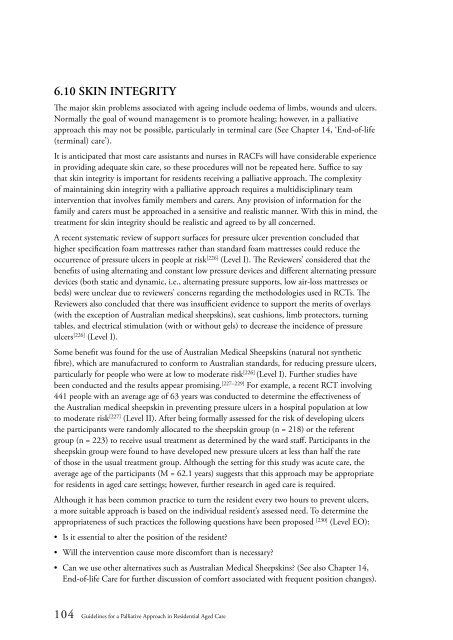Guidelines for a Palliative Approach in Residential Aged Care
Guidelines for a Palliative Approach in Residential Aged Care
Guidelines for a Palliative Approach in Residential Aged Care
You also want an ePaper? Increase the reach of your titles
YUMPU automatically turns print PDFs into web optimized ePapers that Google loves.
6.10 SKIN INTEGRITY<br />
The major sk<strong>in</strong> problems associated with age<strong>in</strong>g <strong>in</strong>clude oedema of limbs, wounds and ulcers.<br />
Normally the goal of wound management is to promote heal<strong>in</strong>g; however, <strong>in</strong> a palliative<br />
approach this may not be possible, particularly <strong>in</strong> term<strong>in</strong>al care (See Chapter 14, ‘End-of-life<br />
(term<strong>in</strong>al) care’).<br />
It is anticipated that most care assistants and nurses <strong>in</strong> RACFs will have considerable experience<br />
<strong>in</strong> provid<strong>in</strong>g adequate sk<strong>in</strong> care, so these procedures will not be repeated here. Suffice to say<br />
that sk<strong>in</strong> <strong>in</strong>tegrity is important <strong>for</strong> residents receiv<strong>in</strong>g a palliative approach. The complexity<br />
of ma<strong>in</strong>ta<strong>in</strong><strong>in</strong>g sk<strong>in</strong> <strong>in</strong>tegrity with a palliative approach requires a multidiscipl<strong>in</strong>ary team<br />
<strong>in</strong>tervention that <strong>in</strong>volves family members and carers. Any provision of <strong>in</strong><strong>for</strong>mation <strong>for</strong> the<br />
family and carers must be approached <strong>in</strong> a sensitive and realistic manner. With this <strong>in</strong> m<strong>in</strong>d, the<br />
treatment <strong>for</strong> sk<strong>in</strong> <strong>in</strong>tegrity should be realistic and agreed to by all concerned.<br />
A recent systematic review of support surfaces <strong>for</strong> pressure ulcer prevention concluded that<br />
higher specification foam mattresses rather than standard foam mattresses could reduce the<br />
occurrence of pressure ulcers <strong>in</strong> people at risk [226] (Level I). The Reviewers’ considered that the<br />
benefits of us<strong>in</strong>g alternat<strong>in</strong>g and constant low pressure devices and different alternat<strong>in</strong>g pressure<br />
devices (both static and dynamic, i.e., alternat<strong>in</strong>g pressure supports, low air-loss mattresses or<br />
beds) were unclear due to reviewers’ concerns regard<strong>in</strong>g the methodologies used <strong>in</strong> RCTs. The<br />
Reviewers also concluded that there was <strong>in</strong>sufficient evidence to support the merits of overlays<br />
(with the exception of Australian medical sheepsk<strong>in</strong>s), seat cushions, limb protectors, turn<strong>in</strong>g<br />
tables, and electrical stimulation (with or without gels) to decrease the <strong>in</strong>cidence of pressure<br />
ulcers [226] (Level I).<br />
Some benefit was found <strong>for</strong> the use of Australian Medical Sheepsk<strong>in</strong>s (natural not synthetic<br />
fibre), which are manufactured to con<strong>for</strong>m to Australian standards, <strong>for</strong> reduc<strong>in</strong>g pressure ulcers,<br />
particularly <strong>for</strong> people who were at low to moderate risk [226] (Level I). Further studies have<br />
been conducted and the results appear promis<strong>in</strong>g. [227–229] For example, a recent RCT <strong>in</strong>volv<strong>in</strong>g<br />
441 people with an average age of 63 years was conducted to determ<strong>in</strong>e the effectiveness of<br />
the Australian medical sheepsk<strong>in</strong> <strong>in</strong> prevent<strong>in</strong>g pressure ulcers <strong>in</strong> a hospital population at low<br />
to moderate risk [227] (Level II). After be<strong>in</strong>g <strong>for</strong>mally assessed <strong>for</strong> the risk of develop<strong>in</strong>g ulcers<br />
the participants were randomly allocated to the sheepsk<strong>in</strong> group (n = 218) or the referent<br />
group (n = 223) to receive usual treatment as determ<strong>in</strong>ed by the ward staff. Participants <strong>in</strong> the<br />
sheepsk<strong>in</strong> group were found to have developed new pressure ulcers at less than half the rate<br />
of those <strong>in</strong> the usual treatment group. Although the sett<strong>in</strong>g <strong>for</strong> this study was acute care, the<br />
average age of the participants (M = 62.1 years) suggests that this approach may be appropriate<br />
<strong>for</strong> residents <strong>in</strong> aged care sett<strong>in</strong>gs; however, further research <strong>in</strong> aged care is required.<br />
Although it has been common practice to turn the resident every two hours to prevent ulcers,<br />
a more suitable approach is based on the <strong>in</strong>dividual resident’s assessed need. To determ<strong>in</strong>e the<br />
appropriateness of such practices the follow<strong>in</strong>g questions have been proposed [230] (Level EO):<br />
• Is it essential to alter the position of the resident?<br />
• Will the <strong>in</strong>tervention cause more discom<strong>for</strong>t than is necessary?<br />
• Can we use other alternatives such as Australian Medical Sheepsk<strong>in</strong>s? (See also Chapter 14,<br />
End-of-life <strong>Care</strong> <strong>for</strong> further discussion of com<strong>for</strong>t associated with frequent position changes).<br />
104 <strong>Guidel<strong>in</strong>es</strong> <strong>for</strong> a <strong>Palliative</strong> <strong>Approach</strong> <strong>in</strong> <strong>Residential</strong> <strong>Aged</strong> <strong>Care</strong>
















